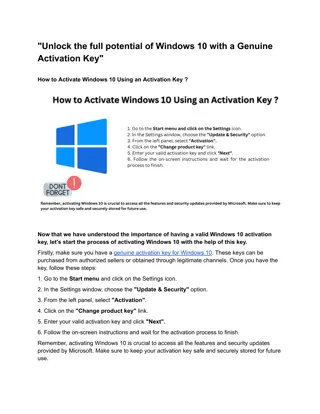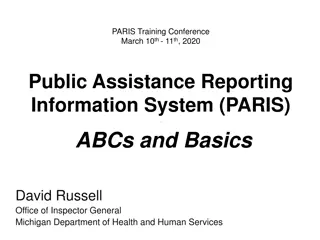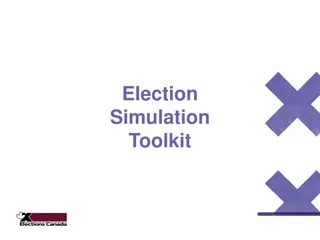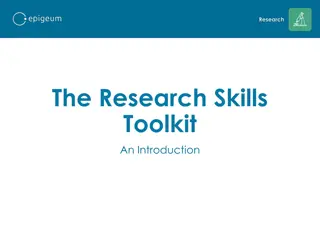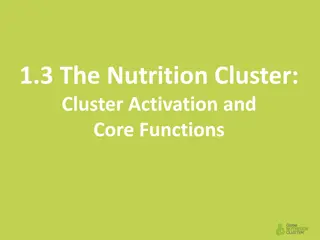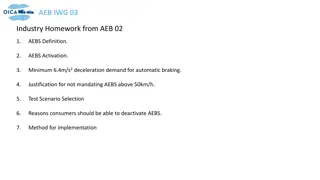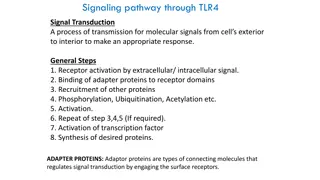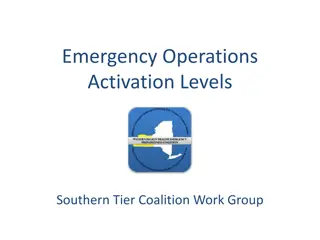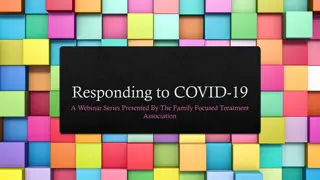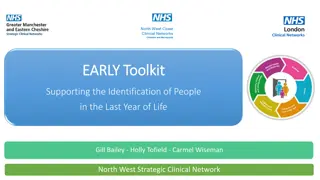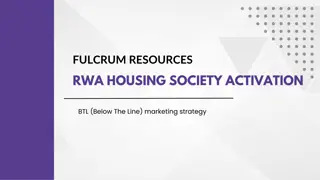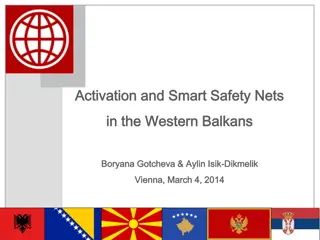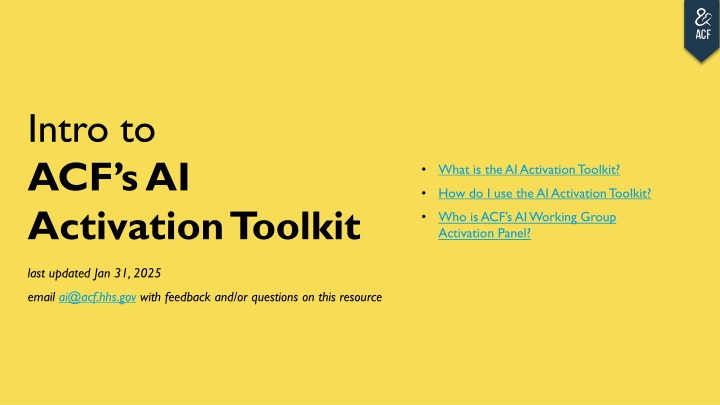
ACF AI Activation Toolkit and Working Group Overview
The ACF AI Activation Toolkit is a resource for teams considering AI use, especially for projects impacting rights or safety. Learn how to use the toolkit, engage with the AI Working Group Activation Panel, and get guidance for successful AI deployment. Contact ai@acf.hhs.gov for inquiries or feedback.
Download Presentation

Please find below an Image/Link to download the presentation.
The content on the website is provided AS IS for your information and personal use only. It may not be sold, licensed, or shared on other websites without obtaining consent from the author. If you encounter any issues during the download, it is possible that the publisher has removed the file from their server.
You are allowed to download the files provided on this website for personal or commercial use, subject to the condition that they are used lawfully. All files are the property of their respective owners.
The content on the website is provided AS IS for your information and personal use only. It may not be sold, licensed, or shared on other websites without obtaining consent from the author.
E N D
Presentation Transcript
Intro to ACF s AI Activation Toolkit What is the AI Activation Toolkit? How do I use the AI Activation Toolkit? Who is ACF s AI Working Group Activation Panel? last updated Jan 31, 2025 email ai@acf.hhs.gov with feedback and/or questions on this resource
What is the ACF AI Activation Toolkit? The ACF AI Activation Toolkit is a resource designed for teams considering the use of AI to address a specific problem. If you are considering using AI for a purpose that could affect people s rights or safety, you must use this AI Activation Toolkit.* If you re thinking about using AI for a purpose that wouldn t affect rights or safety, we still encourage you to use this toolkit. This toolkit applies for both custom-built AI applications and using AI features in off-the-shelf commercial products. Phase 1 Proposal for Integrating AI Phase 2 Design and Delivery Checklist Tools for Measuring Success Use to think through the problem you re trying to solve and why an AI system makes sense Use to ensure you are taking necessary steps to deploy and operate an effective system, avoiding and mitigating risks of bias and other negative unintended consequences Use to define how you will measure whether your AI system achieves the intended goals and how you ll regularly monitor and evaluate the AI system * The AI Activation Toolkit is required when AI is being considered for a purpose that could affect people s rights or safety both because it is a useful accountability exercise to articulate the why and how , and because all federal agencies are required by OMB M-24-10 to conduct AI impact assessments for AI systems that may affect peoples rights or safety. View slide 6 for an explanation of what rights or safety impacting AI means. 2
How do I use the ACF AI Activation Toolkit? 1 Assemble your proposal team, i.e. the people who will shape and lead this potential AI project. Craft a team that brings a wide range of relevant perspectives and experiences, including people who will be directly working with the AI. 2 3 Work through the Phase 1 Proposal for Integrating AI. When you re done, you ll have a presentation you can use to discuss the idea with others. Email ai@acf.hhs.gov when your Phase 1 Proposal for Integrating AI is ready for feedback 4 ACF s AI Working Group Activation Panel will review and reach out with feedback, suggestions, and ideas. If your team decides to move forward with the AI system, use the Phase 2 Design and Delivery Checklist and Tools for Measuring Success to guide you. ACF s AI Activation Team will check in periodically on how things are going. 5 Need help? Reach out to ACF s AI Team at ai@acf.hhs.gov. We re here to support you! 3
Who is ACFs AI Working Group Activation Panel? ACF s AI Activation Team reviews AI Activation Kit Phase 1 Proposals for Integrating AI and provides feedback, suggestions, and ideas. ACF s AI Activation Team is comprised of five people. Each person is tasked to pay particular attention to specific aspects of a potential AI-enabled solution, while also sharing their full perspective and expertise: from ACF Tech, focused on technical feasibility, data privacy, and security Technical Measurement from Office of Planning, Research, and Evaluation (OPRE), focused on measurement of success The Ethics, Change Management, and Alternatives Leads are volunteers from and/or nominated by ACF AI Workgroup members, with approval from their managers and ACF s Chief Artificial Intelligence Officer. These volunteers serve one-year terms, and each represent different offices, with at least two from program offices. Ethics focused on fairness, civil rights, civil liberties, and other externalities Change Management focused on impact on staff, communication, and training needs Alternatives focused on other ways to solve the problem besides AI The AI Activation Team is an advisory resource to ACF teams, but not an approval body for AI systems. The go/no-go decision on an AI system should be made through the typical chain of approval for the involved office(s), if it meets other relevant requirements for information systems. The CAIO does not need to approve all AI systems at ACF but does have the authority to end an AI project that is too high risk to continue or modify it for the efficiency of the federal service. 4
How are we defining AI? Simply put, AI is a wide range of applied math designed to mimic human intelligence, for either specific or general purposes. More specifically, for the purposes of this AI Activation Toolkit, artificial intelligence is defined by Section 238(g) of the John S. McCain National Defense Authorization Act for Fiscal Year 2019 (1025 U.S.C. note prec. 4061; Public Law 115-232), which states that the term artificial intelligence includes the following : 1. Any artificial system that performs tasks under varying and unpredictable circumstances without significant human oversight, or that can learn from experience and improve performance when exposed to data sets. 2. An artificial system developed in computer software, physical hardware, or other context that solves tasks requiring human-like perception, cognition, planning, learning, communication, or physical action. 3. An artificial system designed to think or act like a human, including cognitive architectures and neural networks. 4. A set of techniques, including machine learning, that is designed to approximate a cognitive task. 5. An artificial system designed to act rationally, including an intelligent software agent or embodied robot that achieves goals using perception, planning, reasoning, learning, communicating, decision making, and acting. This definition excludes basic automations including robotic process automation (RPA). It is agnostic to how simple an AI model is: what matters is what the AI is designed to do. For example, if a system integrates a linear regression formula into a workflow, that is still AI even if the formula is as simple as y = ax + b. 5
What does rights or safety impacting AI mean? If AI will have a substantial impact on an action or decision that affects a person s rights or safety, then it s rights and/or safety-impacting AI. Rights such as civil rights, civil liberties, or privacy; equal opportunities including access to education, housing, insurance, employment, and other programs where civil rights and equal opportunity protections apply; or access to or ability to apply for critical government resources or services including healthcare and human services Safety of human life or well-being, including loss of life, serious injury, bodily harm, biological or chemical harms, occupational hazards, harassment or abuse, or mental health, including both individual and community aspects AI Impact Operational Context What agency operation would the AI support? In this context, what does the AI do? Will the AI output have substantial impact* on the action or decision? * What does substantial impact mean? Does this operation result in an action or decision? If yes If yes Can the action or decision affect a person s rights or safety? This use of AI impacts a person s rights/safety If yes 6
Examples of substantial impact Is substantial impact Is not substantial impact AI directly performs an action or makes a decision that may impact rights or safety, regardless of whether that decision is reviewed by a human. AI directly recommends that a human take an action or make a decision that may impact rights or safety. AI outputsinformation that will be provided without substantial human review to a decision maker and will play a substantial part in the decision maker s action or decision that may impact rights or safety. It is not relevant whether the decision maker will also consider other sources of information. AI presents or prioritizes information to a decision maker in a manner that substantially influences their decisions. AI s output will not feed, directly or indirectly, into any rights- or safety-impacting decision- making process. AI s output will not directly be used in any decision-making process. AI s output will be considered in a decision- making process among many other inputs, such that the AI s output will not play any substantial role in the decision reached. 7


